We independently evaluate all recommended products and services. Any products or services put forward appear in no particular order. If you click on links we provide, we may receive compensation.

Vosteed Corgi
Quality/Performance - 61%
Value for Money - 72%
67%
- Pros: Excellent in the pocket thanks to light weight, great clip, straight and slim profile, finger and front flippers, high quality, lots of nice details.
- Cons: An ergonomic non-starter with no solid traction points, small lock release button, finger flipper tab interferes with front flipper operation, bead blasted blade finish.
A lot of the time, our preconceived notions and preferences tinge our perceptions and thus our reviews in ways we don’t know. For me, some brands are always fighting an uphill battle: I expect not to like something and look for things to confirm that bias. After the first SOG I reviewed left a bad taste in my mouth (the Spec Arc was pretty terrible), the next one I looked at a few years later (the Terminus XR) was absolutely swimming against the tide. That knife turned out to be great, but the whole time I reviewed it I was assuming it wouldn’t be.
I have less preconceived notions about Vosteed, since they’re a relatively new brand, but 100% of my experience with their knives has been positive. Both the uniquely-shaped Nightshade LT, designed to be a modernized Shilin cutter with an eye towards food prep, and the well-finished but utilitarian Raccoon left me flabbergasted with how good they were for how little they cost.
Key Specs: Vosteed Corgi
So I was understandably excited when Vosteed shipped out another knife for us to check out, the adorably named Corgi. I love Corgis, and so far I love Vosteeds, so I was figuring this knife would be a home run. Designed by Yue Dong (like all the other Vosteeds so far), the Corgi features Yue’s unique Trek Lock mechanism, symmetrical handles and a blade that hides entirely inside them, and stylistic touches like micarta scales and a copper inlay around the pivot. It’s also inexpensive, listed for $59 on Vosteed’s site. So, I started carrying the Corgi, expecting to love it as much as I love its furry little namesake, but I came away from the experience less impressed than I thought. I don’t want to spoil the whole point of this review, but we’ll just say it’s not an issue of quality but rather of design intention. You might love the Corgi, I’m just not sure it’s for me. Read on to find out more of why that is.
The Blade
The Corgi’s blade measures at a very convenient 2.99” long (just like the Morel‘s), cut from relatively thin blade stock at 0.118” across the spine. I say very convenient because some jurisdictions cap legal blade length at 3” so it’s impractical or ill-advised to carry anything longer than that, a concept that YouTuber Nick Shabazz harps on frequently. So, falling just under that limit means it packs as much blade as possible into a “Chicago Legal” size, which is generally how the community refers to the 3” blade length limit.

The blade shape is a plain drop point with a false swedge along the front half of the spine to thin it out towards the tip, and basically a full flat grind – with just the narrowest remnant of flats at the very top of the primary grind, and a vertical plunge grind with a radiused transition and a small sharpening choil at the back side of the cutting edge. The combination of the drop point blade shape and swedged spine means the knife has good geometry for piercing cuts, but not necessarily for roll cuts – it lacks any belly in the edge, and the entire edge sits above the lower boundary of the handle.
Vosteed sells four variants of the Corgi – black or green micarta handles with a stonewashed and bead blasted blade, a green micarta with a black PVD stonewashed blade, or a light grey G10 with a satin finish blade. Our test sample is the black micarta with the bead blasted and stonewashed finished, leaning heavily towards bead blasted in appearance – sort of a dull grey that you can see the stonewashed finish underneath if you look at just the right angle.
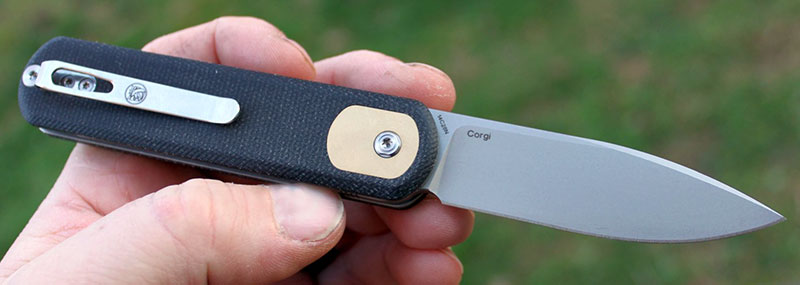
All four versions of the Corgi use Sandvik 14c28n steel, the same as the Raccoon we reviewed previously, also used widely on entry-level EDC knives from companies like Civivi, Kershaw, and QSP. It’s not a powdered metallurgy steel but designed to be a high-performance ingot-formed steel capable of fine blanking (being press-cut into the proper shape for faster production). It’s got good carbon content for a budget steel, 0.6%, and sports 14% chromium for corrosion resistance as well as 0.11% nitrogen for improved toughness. I’m not a metallurgist, but Knife Steel Nerds is, and he rates 14c28n as arguably the best budget knife steel out there for its balance of toughness, corrosion resistance and edge retention. For a $60 EDC knife you’re usually going to see either D2 or 14c28n, and I prefer 14c28n because it’s easier to sharpen and harder to stain or rust, even if D2 holds an edge longer.
Deployment & Lockup
The Corgi utilizes the Trek Lock, a variant of a plunge lock that was designed by Yue Dong, for lockup, and has a set of flippers – a finger flipper as well as a front flipper or thumb flipper – for deployment. Yue was involved in the development of the Kizer Cormorant, so the lock mechanism of the Corgi will feel familiar to anyone who’s used one of those knives. While the principle of the plunge lock still works the same – a coil spring applies pressure to the plunger, holding the blade closed in a detent as well as dropping into a round cutout in the open position to hold it open – it differs from a regular plunge lock in the placement.

There’s a semicircular cutout in the tang of the blade which both the stop pin and the lock itself pass through, with a chamfered edge creating the closed detent and a flat circle creating the locked open position. Pressing the button pushes the plunger out of the way of the circular channel and allows the blade to move again. With an internal stop pin that works in the open position only and a portion of the tang cut out to pass the parts through, you should not expect the Trek Lock to hold up to heavy abuse, but it has its advantages. Since the components are housed inside the blade it’s harder for dirt or lint to make their way into the mechanism, and it also gives the knife a clean minimalistic appearance with the lock release in line with the pivot – which helps to prevent accidental release of the lock when in use.
Deployment is courtesy of caged ceramic ball bearings in phosphor bronze cassettes, actuated by either a front flipper or a finger flipper. Since the whole design of the knife is symmetrical, the rounded edges of the handles cut away at the front to allow access to the squared off flipper tabs, both of which feature jimping on their corners for additional traction. The finger flipper works great, with a crisp snap and a relatively light detent. Try as I might, I still cannot gel with a front flipper after all these years, finding the technique obstructive and overly complicated to use when I actually need to cut something open versus just fidgeting with the knife. I also find that when I use the front flipper on the Corgi, the rear (finger) flipper catches on the pad of my index finger and stops the blade from opening fully. I will say that the addition of the front flipper doesn’t take anything away from the design; in fact, if it were missing it would throw off the whole symmetrical vibe of the knife, so I don’t mind that it’s there, I just don’t use it.
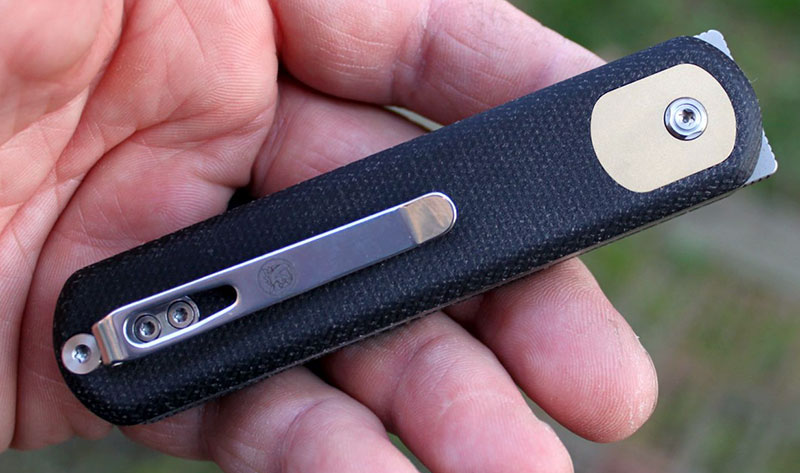
Lockup with the Trek Lock is good, with no discernible blade play in either the vertical or horizontal axes. I also never noticed any lock stick, even during initial break-in, which speaks well to quality. My only complaint with lockup is that the diminutive size of the lock release button makes closing the knife fiddly, but it works just fine. It’s just less intuitive than the regular button lock on the Raccoon.
Features, Fit & Finish
Vosteed’s products so far have a notable focus on wowing customers with small details, and if the minutiae are your thing there’s joy to find in the Corgi. Most notable are the brass inlays that surround the pivot on both sides, as well as the button release on the lock side of the handle. They’ve got an oblong, rounded-off rectangle shape that brings a splash of contrast to the handles, which are black micarta on our test sample. Both materials are durable but also collect a patina, especially the inlays which get a natural tarnish from the oils in your skin – but so does the porous surface of the micarta scales, which gradually absorbs oils and dust to become darker around the edges, like a pair of well-worn denim jeans. I like the grey G10 version with white G10 inlays and a satin blade, but it will never acquire the same lived-in look that this brass/micarta variant will.
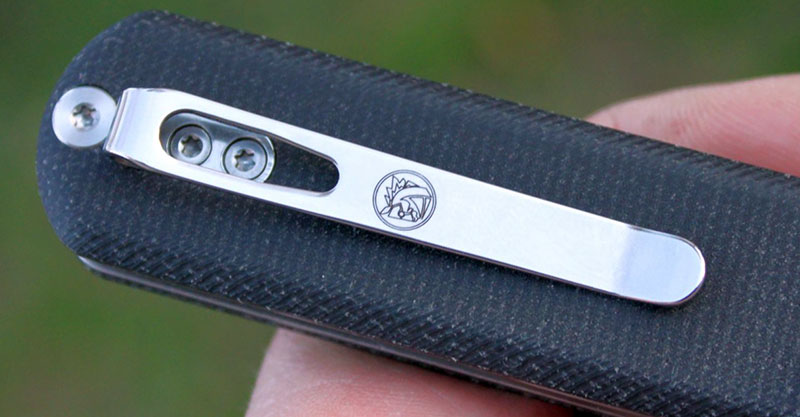
Little details are everywhere: the fine diamond cross-hatch pattern on the lock release button, the small but sculpted triangular pivot screws, the countersunk oversized rear body screw with a polished finish, and the smoothly rounded edges of the micarta scales that are perfectly even with the liners. This is all intentional design, like the blade that hides entirely inside the handles when closed, the top of the spine perfectly level with the liners in the closed position, with only the flipper tabs protruding from the edges of the handles. The loop-over deep carry pocket clip is polished stainless steel with the Vosteed logo etched onto it, secured in a slot on the handle by two vertically oriented screws; it is only configured for right-hand tip-up carry. A plastic backspacer sits in between the liners at the rear, with a cutout and a metal pin serving as a lanyard pass-through in the top rear corner of the handle.

It’s all extremely well made, with all the layers fitting together seamlessly, nothing to even catch the corner of your thumbnail on as you brush it across adjoining surfaces. The blade that disappears into the handles is of course perfectly centered in between the liners, and my only QC gripe is the slightly uneven edge grind that’s just barely steeper on the lock side than the show side and with a rougher grit finish than I like to see; otherwise, it’s a very well-finished knife, just like the last two we’ve reviewed from Vosteed.

Construction of the Corgi is bolt-through, using a pair of skeletonized stainless-steel liners to hold everything together, with a series of holes drilled in them to reduce weight. The pivot screw is a Chicago-style setup with the female pivot barrel on the lock side and the threaded male screw on the show side of the blade, the pivot barrel being keyed to the frame with a D-shaped cutout to prevent it from turning with the screw. Both the pivot and body screw at the far end are Torx T8, while the two pocket clip screws are T6. It is worth noting that if you unscrew the male pivot screw, the brass inlay will come out with it – since that inlay is what holds the spring for the lock in place, so the spring will force the plate out as the screw is removed.
Field Test
The Corgi weighs in at 3.44 ounces (3.53 if you choose the G10 variant) and has a handle length of 4.18” and a handle height of just shy of 1” and width of 0.48” – so it’s quite slim in the pocket, aided by the lack of protruding flipper tabs or odd shapes owing to its minimalist design. With the light weight, small profile, and polished stainless deep carry clip contacting a micarta surface with just the right amount of traction, this knife carries very well – it doesn’t weigh you down or take up any more space than it needs to. It can be tricky to get into your pocket due to the shallow angle at the leading edge of the clip, which is a trade-off since it means it’s less likely to snag on things as you walk by.
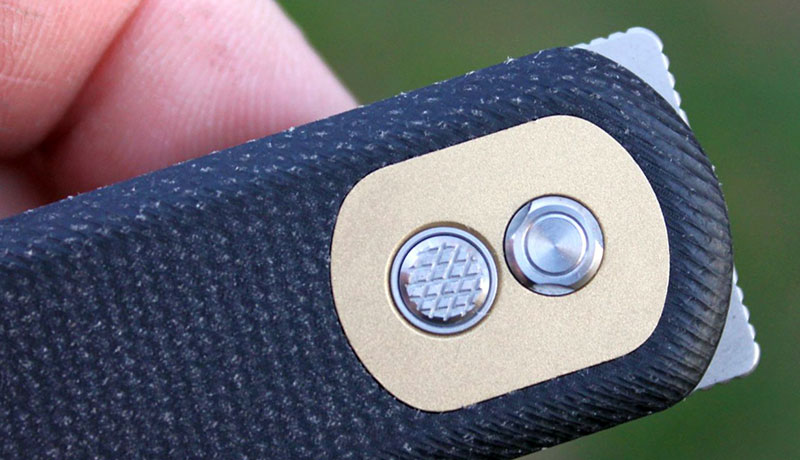
So carry is good, but how is use? While I love the minimalistic, symmetrical design and hide-away blade of the Corgi, it doesn’t lend itself to ergonomic excellence with its flat handles. There is no finger guard when open, no jimping to hold your fingertips in place, no swell to grab on to, it just sort of feels like a bar of soap in your hand. This shape would make for a fine steak knife, but if you’re busting open your pocketknife to break down some cardboard boxes or open a new acquisition in thick plastic blister packaging, you generally want a more positive grip when in use than the Corgi provides. The materials themselves aren’t slippery; micarta always feels good in the hand and doesn’t become slick when wet, but the shape itself is more urban gentry than backwoods tree-stabber. And that’s totally fine if you’re only using the knife to open mail or cut an apple at a picnic, but that’s just not my use case for pocketknives – I frequently have nitrile gloves with oil or brake fluid on when I need to cut something open.

That’s a matter of preference though, not a disqualifying complaint against the knife. These thin, minimalist “gentleman’s carry” folders are attractive but offer limited functionality to me, especially compared to similarly priced competition with more of an eye towards functionality and grip – like the equally priced Raccoon, which also uses the same materials (14c28n, micarta, stainless liners) with an easier to operate lock and thumb stud opening.
Handle ergonomics aside, the blade on the Corgi does a great job of cutting through daily obstacles – being keen to pierce things thanks to the thinned-out tip from the swedge along the spine and the thin blade stock. A flat ground drop point is always a well-balanced blade shape for EDC use, although this one could benefit from a little more belly for roll cuts – the profile is relatively flat to allow it fit entirely inside the handles when closed.
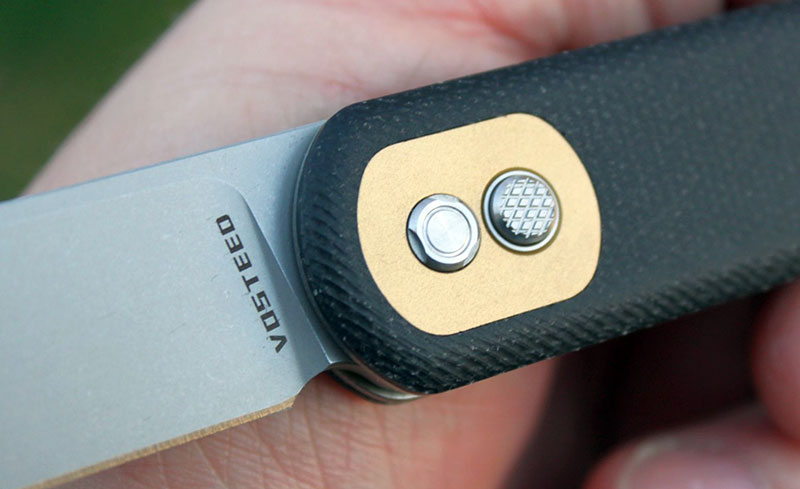
Maintenance isn’t a hassle either, thanks to the flow-through construction allowing you to easily blow lint out of the body with compressed air, and there’s not much need to disassemble the knife for cleaning the pivot and lock since they’re housed inside the tang of the blade and less likely to accumulate dirt. 14c28n doesn’t hold an edge as long as some newer budget steels like BD1N, but it’s still just fine for EDC use, able to be touched up on a guided rod sharpener in just a few minutes – especially thanks to the relatively straight sharpened edge of the blade. The bead blasted finish on the blade seems to attract scratches and lint much more readily than a full stonewash would, but less likely to show blemishes than a vertical satin finish. The only issue I had while I carried the Corgi was that the pocket clip would drift off center by a few degrees from the screws working themselves loose, which was easy enough to fix with a small bit driver.
Alternatives
All these knives available at BladeHQ.
The Corgi comes in four varieties, all of which run $59 direct on Vosteed’s website. For that $59, my preference is the Raccoon, which is available in the button lock we tested and now a cross-bar lock variant that’s even more lefty-friendly. I like the more pronounced ergonomics of the Raccoon, and it brings the same materials and quality to the table at the same price.

If you dig the folding gentleman’s knife aesthetic, I can recommend the Boker Plus Urban Trapper Flipper. It’s got a longer blade at 3.5” and 7.75” overall length when open, but manages to weigh only 1.92 ounces with G10 scales and stainless liners, thanks to its extremely slim profile. It’s pricy at ~$120 retail but the Urban Trapper is one of the best flippers around and its unique design and high blade length to weight ratio makes it compelling, as do other pricier variants in exotic woods or full titanium. It’s never been a super practical knife, but it is very cool.

We reviewed the Kizer Feist a few years ago, in its original titanium version. The Justin Lundquist-designed knife melds old school lines and simplicity with a modern opening method (a front flipper) as well as a bearing pivot and a framelock. They’ve since expanded the Feist line to include different blade shapes and handle materials, including this Micarta-handled Feist XL with a liner lock and a 3.4” spear point blade in 154CM steel, bringing the MSRP down to ~$90 from the original titanium model’s hefty ~$170. It’s a little bigger at 7.75” overall (the Corgi measures 7.17” when open), and comparable in weight at 3.1 ounces. I like the Feist’s front flipper better than the Corgi’s, but the Corgi also includes a finger flipper as well. Both fill a similar section of the market and are very well made, and thankfully the Micarta Feist ditches the irritating sculpted titanium clip for a regular bent steel clip. It still sports that sleek rounded spine blade, too.

Finally, if you’re after an affordable front flipper that’s high quality, the Petrified Fish Beluga is worth a look. At only ~$50 retail price, the smaller Beluga offers a 3” drop point in Sandvik 14c28n, front flipper deployment via ball bearings, and a liner lock. It comes in at 6.8” overall and weighs 3.37 ounces, with a deep carry tip-up pocket clip that’s reversible, slotting into the back of the handle. The Beluga doesn’t have the same super-slim symmetrical build as the Corgi, but it’s still worth considering if you’re after a front flipper in this price range.
Wrap-Up
The Vosteed Corgi is an attractive, well-made, neat-looking knife that’s a little too form-over-function for my personal taste. Which is fine, because everyone’s allowed to like what they like, and I personally prefer the more utilitarian – and identically priced and spec’d – Raccoon button lock. But there are benefits to the unusual design – it carries very well and takes up the absolute minimum footprint in your pocket, and it’s fun to fiddle with. If you’re after the aesthetic look of a slim, minimalist gentleman’s folder this may be your ticket, but I prefer a little more solid ergonomics over the cool looks.





